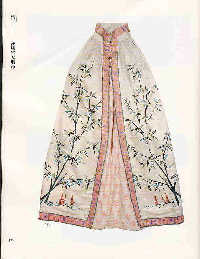 Dun Zi was a kind of underwear, collarless and sleeveless. Unlike Kan Jian, it was shorter and more close-fitting, with buttons down the oxter (armpit).
Dun Zi was a kind of underwear, collarless and sleeveless. Unlike Kan Jian, it was shorter and more close-fitting, with buttons down the oxter (armpit).
Du Dou, the bellyband, was the most mysterious and charming member in traditional Chinese costumes and popular among children and women in old Beijing. The bellyband was very formfitting and simple, usually with bright colors of red and yellow and embroidery patterns of flowers and birds, fresh peaches, and lovely moppets, full of Chinese ethnical feature and the sense of decoration. It was generally square in shape, with the above angle cut away to turn into two angles linked with a cloth or silk strip. The left and right angles each had a strip. The bellyband could nicely girdle the waist when hanged from the neck and tied at the back. The feminine Du Dou now has regained its spirit and life.
The waistband, about 0.3 meters wide, was usually favored by the elders. The thick band could keep the waist from cold by girdling it, with buttons down the right and the left sides.
During the Qing period, women wore two-piece clothing: one being the Ao (jacket), and one being the Qun (skirt), and sometimes pants.
The Manchu females had a custom of wearing Qixie (Manchu shoes) and males wearing boots. Officials wore square-toed boots, and commoners wore pointed-toed boots. Materials of the boots include satin, woven silks, cloth and leather, and so on. The Manchu shoes for women had a piece of flat wood as the tread, called "flat-tread shoes." Usually, there were colorized brims or bead string patterns on both the upper and the vamp.